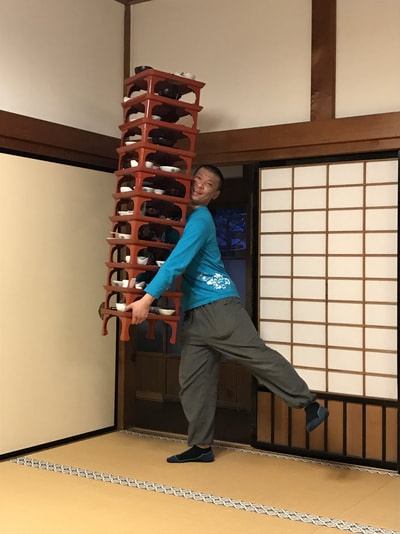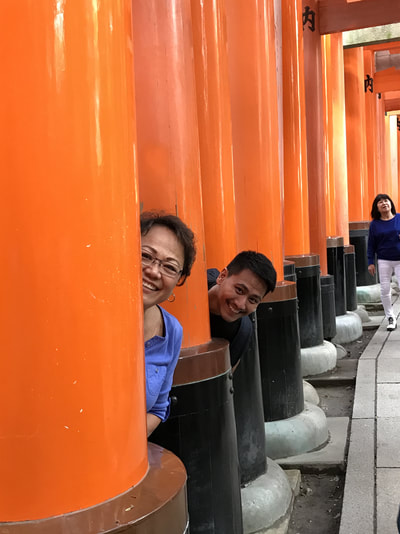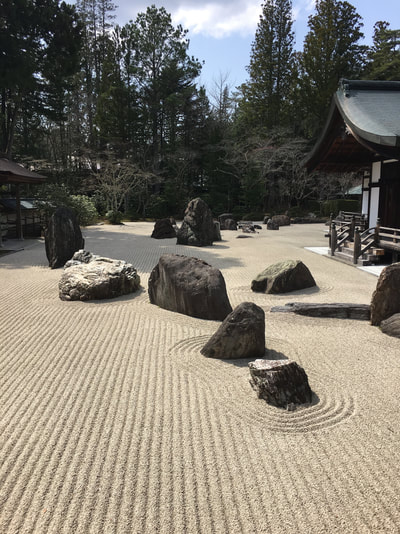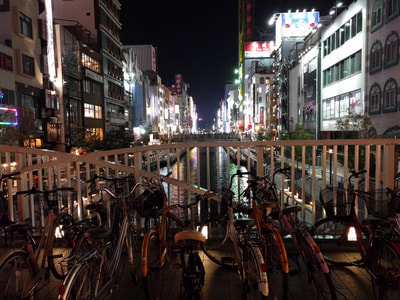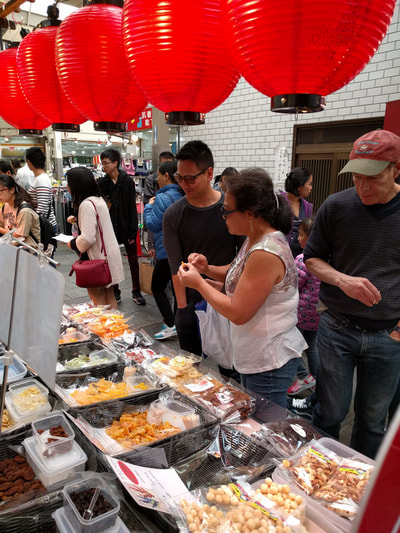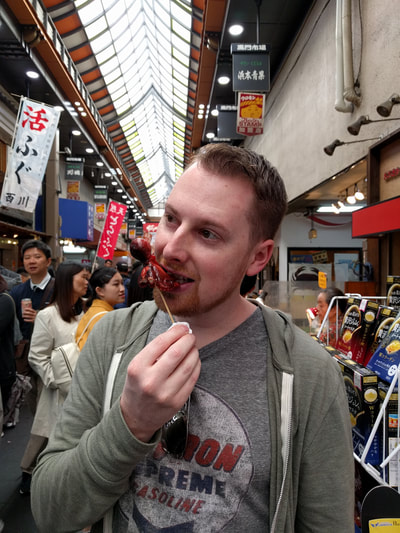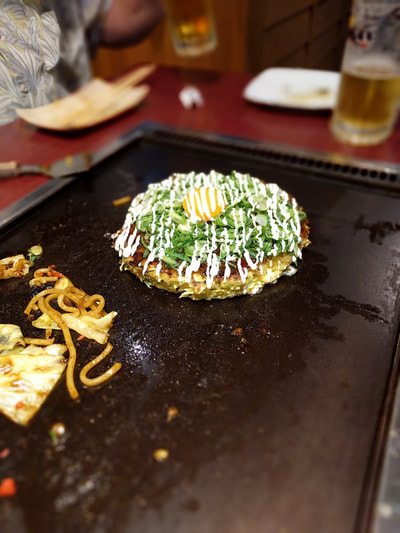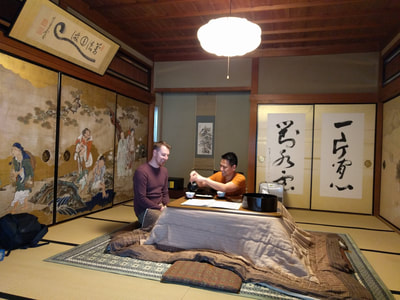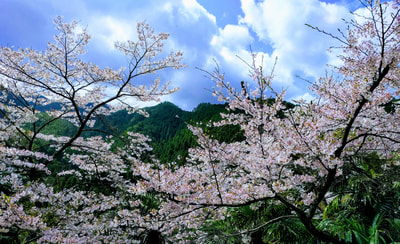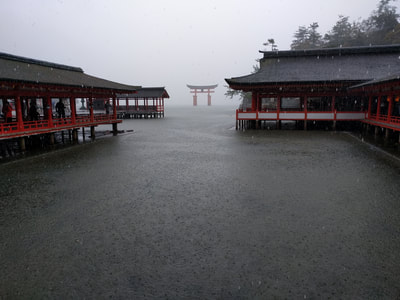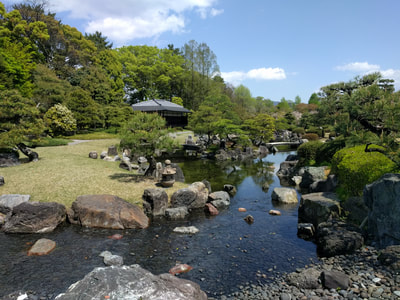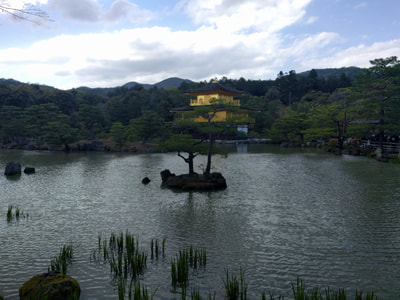-
Itinerary
-
Accommodations
-
Packing List
-
Tips & Guidebook
-
Photos
<
>
I had a great time exploring several regions of Japan from small towns to big cities. Listen to a podcast below where I talk about one of my favorite parts of the trip; the food! You'll also get some travel tips and learn about river cruising before the Japan food talk which starts around the 8 minute mark. Alternatively, click here to listen to this and other travel related podcasts.
9 days: Osaka to Tokyo
From the Buddhist monks of Koyasan to the high rollers of Tokyo, capture the many faces of Japan on this condensed tour beginning in Osaka. Savor the region’s culinary delicacies and the beautiful views at Mt Fuji. You'll stay in a traditional ryokan and really soak up local culture in onsen hot springs. A great combination of the traditional and the contemporary, this adventure provides a taste of the rich culture of Japan.
Highlights
Cities to to visit
Call (408)-718-4872 or email [email protected] today to ask about this adventure!
Now for those who like the nitty gritty details...
Itinerary
Day 1 Osaka
Arrive at any time.
The adventure begins tonight. Feel free to explore your surroundings and discover what this city has to offer.
Day 2 Osaka/Koyasan
Depart early and travel to the centre of Buddhism in Japan and sleep in a temple atop the 800m Mt Koya. Savour a traditional dinner
of shojin ryori (Buddhist vegetarian cuisine). Watch the monks pray in the morning.
Journey to Mt Koya, a religious centre founded in 816 by the Buddhist monk Kobo Daishi. The train ride up the mountain is possibly
one of the finest rail journeys in Japan. For the final steep ascent, switch to funicular and then hop on a bus to reach the monastery.
In the evening, dine on shojin-ryori, typical vegetarian cuisine, and relax in a yukata, or kimono.
Train
Osaka - Koyasan
Climb aboard, take a seat, and enjoy the ride.
Overnight in Mount Koya Temple
Koyasan
During the overnight stay in the mountain temple, witness the routines of the monks and dine on typical fare. Explore the temples and
moss covered Oku-no-in cemetery in the afternoon. In the evening, savour the shojin-ryori vegetarian cuisine, and relax in a yukata or
kimono. Early morning at the temple offers the chance to observe the monks praying, before a vegetarian breakfast. Breathe the fresh
mountain air and soak in the beautiful surroundings.
Oku-no-in Cemetery Visit
Koyasan Afternoon
Oku-no-in is the most sacred site in Koyasan and the location of the mausoleum for Kobo Daishi (also known as Kukai), the founder
of Shingon Buddhism. The area is surrounded by a massive cemetery, the largest in Japan. With over 200,000 tombstones lining the
almost 2km path to Kobo Daishi's mausoleum, there is plenty of area to explore. Be sure to see Torodo Hall (Hall of Lamps), the main
place of worship, where more than 10,000 lanterns are kept burning day and night.
Day 3 Koyasan/Hiroshima-shi
Watch the monks pray in the morning and enjoy a traditional breakfast before travelling to Hiroshima.
Early morning offers the chance to observe the monks praying. Breathe in some fresh mountain air before a vegetarian breakfast,
then start the journey back down the mountain via bus, train and funicular.
Later, board a train to Hiroshima, a historically significant city, marked by the explosion of the first atomic bomb in 1945.
Bullet train
Koyasan - Hiroshima-shi
Get to your next destination faster than the speed of flight (ok maybe not that fast) aboard a high-speed train.
Free Time
Hiroshima-shi Afternoon
Explore all this city has to offer.
Day 4 Hiroshima-shi
Visit the Peace Park and Memorial Museum and take a ferry ride over to the sacred island of Miyajima to see the famous floating torii
gate.
Peace Park and Museum Visit
Hiroshima-shi
Walk through the Peace Park in the centre of Hiroshima, a living memorial dedicated to the tens of thousands who died from the
atomic bomb blast in 1945. Visit the statue of Sadako Sasaki, a young girl who died of leukemia as a result of the bomb blast, despite
folding 1,000 origami paper cranes to appeal to the gods to make her well. See the frame of the Gembaku Dome, the sole building to
withstand the explosion. Reflect, remember, and be reminded of the power we all hold to create peace.
Ferry
Hiroshima-shi - Miyajima
Hop a ferry to reach the island and journey back in the evening.
Miyajima Island Visit
Miyajima
Take a trip to Miyajima Island, famed as one of Japan's most scenic spots, with a free afternoon to explore. See the famous floating
Torii Gate, set out in the bay, which glows extraordinarily at sunset. The island is dotted with shrines and temples, populated by deer
and monkeys, and traversed with hiking trails for those who want to get some exercise. There are also lanes full of souvenirs and
tasty treats. Visit Miyajima at your own pace, and have the option to hike up to the peak of the island, Mt Misen, to see spectacular
views of the surrounding islands.
Free Time
Miyajima Afternoon
Free time on Miyajima Island to make the most of this beautiful location.
Optional Activities - Day 4
Mt. Misen Visit
Miyajima 2-6km
Free-1800JPY per person
Set out for the summit of Mt. Misen, Miyajima's highest peak at 500m (1,640 ft) above sea level. Opt to hike one of three trails through
the forest and keep an eye out for wild deer or catch a ride on the ropeway and walk the remaining distance to the top. Take in great
views of the Seto Inland Sea and on a clear day see as far as the city of Hiroshima.
Day 5 Hiroshima-shi/Kyoto
Travel to Kyoto and start exploring. Enjoy a visit to the beautiful Fushimi Inari Taisha shrine.
Visit zen gardens and pavillions, and the Gion area in the evening. WIth plenty of time to explore, opt to visit museums, palaces,
temples, zen gardens, and restaurants.
Take long walks along the river, through the Inari Gates, or along the Philosopher's path to Nanzen-ji. Stroll around Gion, catch a
traditional tea ceremony, get a fantastic meal, and see locals dressed in traditional kimono.
Bullet train
Hiroshima-shi - Kyoto
Get to your next destination faster than the speed of flight (ok maybe not that fast) aboard a high-speed train.
Fushimi Inari Taisha Shrine Visit
Kyoto
Pay a visit to Fushimi Inari shrine, located just outside of Kyoto. Walk under the thousands of iconic torii gates (as seen in the film
Memoirs of a Geisha) and enjoy the peaceful atmosphere. The shrine itself is at the base of the Inari mountain but includes many
trails up to smaller shrines in the area.
Free Time
Kyoto Afternoon
Explore as much as you can in Kyoto.
Optional Activities - Day 5
Philosopher's Walk
Kyoto
This stone path through the northern part of Kyoto's Higashiyama district follows a canal lined by hundreds of cherry trees. These
trees come to life during a period known as "Hanami", generally from the end of March to early May. Their iconic pink blossoms are
one of the most famous symbols of Japan.
Day 6 Kyoto
Visit the impressive Nijo Castle and gardens along with the famous Kinaku-ji Golden Pavilion, and practice meditation in Daisen-in's
Zen rock garden.
Nijo Castle and Gardens Visit
Kyoto
Visit the Nijo Castle, the residence of the first shogun of the Edo Period built in 1603. Now a UNESCO World Heritage Site, the
property is divided into three areas: the Honmaru (main circular fortification), Ninomaru (secondary circle of defense), and the
gorgeous gardens that surround both.
Kinkaku-ji Golden Pavilion Visit
Kyoto
Explore Kinkaku-ji or the Golden Pavilion, named for the temple's top two floors that are covered in gold leaf. The temple is
surrounded by trees and sits on a reflective pond, making this must-see in Kyoto a perfect place for photos. While the temple can be
busy, there are gardens around the area to explore once you've had enough of the view.
Daisen-in Zen Rock Garden Visit
Kyoto
Take a walk through the gardens around Daisen-in Temple. This zen garden uses gravel, sand and stones to recreate a river and
ocean, symbolizing the Buddhist journey through life.
Optional Activities - Day 6
Philosopher's Walk
Kyoto
This stone path through the northern part of Kyoto's Higashiyama district follows a canal lined by hundreds of cherry trees. These
trees come to life during a period known as "Hanami", generally from the end of March to early May. Their iconic pink blossoms are
one of the most famous symbols of Japan.
Zen Gardens of Ryoan-ji
Kyoto
500JPY per person
The Ryoan-ji garden is one of the best examples of kare-sansui, or dry landscape, a type of Zen garden. Fifteen large rocks are
placed within a sea of white pebbles raked into linear patterns to facilitate meditation. Stand on the platform to get the best view from
above. Stroll the grounds around the Ryoan-ji Temple and along the Kyoyo-chi pond.
Day 7 Kyoto/Hakone
Take a boat ride on Lake Ashino-ko and a walk along the Old Tokaido Highway, and hopefully catch a glimpse of majestic Mt Fuji.
Enjoy a stay in traditional ryokan accommodation, feast on a Japanese multi-course kaiseki meal, soak in the natural hot springs, and
sleep on a futon.
Travel to Hakone, a town in the hills famous for its onsens, or natural hot springs. Stay in a traditional ryokan, with its own private
onsen.
In the evening, enjoy the ryokan, savouring a complex meal of traditional Japanese foods, followed by a recommended soak in the
onsen.
Bullet train
Kyoto - Odawara
Get to your next destination faster than the speed of flight (ok maybe not that fast) aboard a high-speed train.
Local bus
Odawara - Hakone
Climb aboard, grab a seat, and enjoy the ride.
Lake Ashino-ko Boat Ride
Hakone
Hop aboard a passenger boat to cruise the waters of Lake Ashinoko. If you are lucky, on a clear day you can capture a view of
Mt Fuji. The lake was formed from the caldera of Mt Hakone following its eruption 3000 years ago. Sit back, relax and enjoy.
Traditional Ryokan Stay with Kaiseki Meal
Hakone
Enjoy the ryokan, savour a complex meal of traditional Japanese foods, then finish the day with a soak in the onsen.
Day 8 Hakone/Tokyo
Head to Tokyo with time to do some last-minute shopping.
Arrive before noon to Tokyo, with time to explore this energetic metropolis.
Opt to visit Ueno park and the museums, Akihabara for cutting edge electronics, Harajuku for funky fashions, Ginza for the highest of
the high end, walk the grounds of the Imperial Palace East Garden, or just stroll the streets, looking for the traditional life that still lies
just under the modern surface.
Bullet train
Hakone - Tokyo
Get to your next destination faster than the speed of flight (ok maybe not that fast) aboard a high-speed train.
Free Time
Tokyo Afternoon
With so much to do, start exploring now.
Optional Activities - Day 8
Ueno Park Visit
Tokyo
As Japan's most popular city park, Ueno is known for its museums and cherry blossoms. Stroll the pathways, admire the thousands of
trees, including 1,200 cherry trees, look for lotus on the pond and visit the temples and museums.
Akihabara Visit
Tokyo
Tokyo's Akihabara district is a cultural centre and shopping district for video games, anime, manga, and electronics.
Harajuku Visit
Tokyo
The Harajuku district is known as the centre of Japanese youth culture and fashion. Here, find dozens of shopping and dining options
including independent boutiques and larger international luxury stores.
Ginza Shopping
Tokyo
The Ginza district is Tokyo's equivalent of Fifth Avenue in New York. Window shop at Chanel, Dior, Gucci and Louis Vuitton, then
check out the latest electronics at the Sony showroom or Apple store. Visit the Wako department store with its historic clock tower,
housed in a building that dates back to 1894. If you are there on a weekend, head to Ginza's main street where pedestrians rule
without Tokyo's traffic.
Imperial Palace East Gardens Walk
Tokyo
The Imperial Palace in Tokyo's city centre is home to Japan's Emperor and Empress. It is surrounded by a moat and three gardens,
all open to the public. Stroll throughout the grounds, admire the azaleas and hydrangeas (when in season), discover the original stone
wall that surrounded the palace back in 17th to 19th centuries during the days when samurai warriors defended the ruler. Visit nearby
Sannomaru-Shozo-kan museum and see exquisite kimonos and Japanese paintings.
Day 9 Tokyo
Depart at any time.
Highlights
- Overnight in a temple on Mt Koya with traditional meals
- Hiroshima Peace Park and Museum visit
- Miyajima excursion with floating torii gate visit
- Nijo Castle and gardens visit (Kyoto)
- Kinkaku-ji Golden Pavilion visit
- Daisen-in Temple and Zen garden visit
- Fushimi Inari shrine visit
- Lake Ashino-ko boat ride (Hakone)
- Traditional ryokan stay with kaiseki meal
Cities to to visit
- Osaka
- Kōyasan
- Hiroshima-shi
- Kyoto
- Hakone
- Tokyo
Call (408)-718-4872 or email [email protected] today to ask about this adventure!
Now for those who like the nitty gritty details...
Itinerary
Day 1 Osaka
Arrive at any time.
The adventure begins tonight. Feel free to explore your surroundings and discover what this city has to offer.
Day 2 Osaka/Koyasan
Depart early and travel to the centre of Buddhism in Japan and sleep in a temple atop the 800m Mt Koya. Savour a traditional dinner
of shojin ryori (Buddhist vegetarian cuisine). Watch the monks pray in the morning.
Journey to Mt Koya, a religious centre founded in 816 by the Buddhist monk Kobo Daishi. The train ride up the mountain is possibly
one of the finest rail journeys in Japan. For the final steep ascent, switch to funicular and then hop on a bus to reach the monastery.
In the evening, dine on shojin-ryori, typical vegetarian cuisine, and relax in a yukata, or kimono.
Train
Osaka - Koyasan
Climb aboard, take a seat, and enjoy the ride.
Overnight in Mount Koya Temple
Koyasan
During the overnight stay in the mountain temple, witness the routines of the monks and dine on typical fare. Explore the temples and
moss covered Oku-no-in cemetery in the afternoon. In the evening, savour the shojin-ryori vegetarian cuisine, and relax in a yukata or
kimono. Early morning at the temple offers the chance to observe the monks praying, before a vegetarian breakfast. Breathe the fresh
mountain air and soak in the beautiful surroundings.
Oku-no-in Cemetery Visit
Koyasan Afternoon
Oku-no-in is the most sacred site in Koyasan and the location of the mausoleum for Kobo Daishi (also known as Kukai), the founder
of Shingon Buddhism. The area is surrounded by a massive cemetery, the largest in Japan. With over 200,000 tombstones lining the
almost 2km path to Kobo Daishi's mausoleum, there is plenty of area to explore. Be sure to see Torodo Hall (Hall of Lamps), the main
place of worship, where more than 10,000 lanterns are kept burning day and night.
Day 3 Koyasan/Hiroshima-shi
Watch the monks pray in the morning and enjoy a traditional breakfast before travelling to Hiroshima.
Early morning offers the chance to observe the monks praying. Breathe in some fresh mountain air before a vegetarian breakfast,
then start the journey back down the mountain via bus, train and funicular.
Later, board a train to Hiroshima, a historically significant city, marked by the explosion of the first atomic bomb in 1945.
Bullet train
Koyasan - Hiroshima-shi
Get to your next destination faster than the speed of flight (ok maybe not that fast) aboard a high-speed train.
Free Time
Hiroshima-shi Afternoon
Explore all this city has to offer.
Day 4 Hiroshima-shi
Visit the Peace Park and Memorial Museum and take a ferry ride over to the sacred island of Miyajima to see the famous floating torii
gate.
Peace Park and Museum Visit
Hiroshima-shi
Walk through the Peace Park in the centre of Hiroshima, a living memorial dedicated to the tens of thousands who died from the
atomic bomb blast in 1945. Visit the statue of Sadako Sasaki, a young girl who died of leukemia as a result of the bomb blast, despite
folding 1,000 origami paper cranes to appeal to the gods to make her well. See the frame of the Gembaku Dome, the sole building to
withstand the explosion. Reflect, remember, and be reminded of the power we all hold to create peace.
Ferry
Hiroshima-shi - Miyajima
Hop a ferry to reach the island and journey back in the evening.
Miyajima Island Visit
Miyajima
Take a trip to Miyajima Island, famed as one of Japan's most scenic spots, with a free afternoon to explore. See the famous floating
Torii Gate, set out in the bay, which glows extraordinarily at sunset. The island is dotted with shrines and temples, populated by deer
and monkeys, and traversed with hiking trails for those who want to get some exercise. There are also lanes full of souvenirs and
tasty treats. Visit Miyajima at your own pace, and have the option to hike up to the peak of the island, Mt Misen, to see spectacular
views of the surrounding islands.
Free Time
Miyajima Afternoon
Free time on Miyajima Island to make the most of this beautiful location.
Optional Activities - Day 4
Mt. Misen Visit
Miyajima 2-6km
Free-1800JPY per person
Set out for the summit of Mt. Misen, Miyajima's highest peak at 500m (1,640 ft) above sea level. Opt to hike one of three trails through
the forest and keep an eye out for wild deer or catch a ride on the ropeway and walk the remaining distance to the top. Take in great
views of the Seto Inland Sea and on a clear day see as far as the city of Hiroshima.
Day 5 Hiroshima-shi/Kyoto
Travel to Kyoto and start exploring. Enjoy a visit to the beautiful Fushimi Inari Taisha shrine.
Visit zen gardens and pavillions, and the Gion area in the evening. WIth plenty of time to explore, opt to visit museums, palaces,
temples, zen gardens, and restaurants.
Take long walks along the river, through the Inari Gates, or along the Philosopher's path to Nanzen-ji. Stroll around Gion, catch a
traditional tea ceremony, get a fantastic meal, and see locals dressed in traditional kimono.
Bullet train
Hiroshima-shi - Kyoto
Get to your next destination faster than the speed of flight (ok maybe not that fast) aboard a high-speed train.
Fushimi Inari Taisha Shrine Visit
Kyoto
Pay a visit to Fushimi Inari shrine, located just outside of Kyoto. Walk under the thousands of iconic torii gates (as seen in the film
Memoirs of a Geisha) and enjoy the peaceful atmosphere. The shrine itself is at the base of the Inari mountain but includes many
trails up to smaller shrines in the area.
Free Time
Kyoto Afternoon
Explore as much as you can in Kyoto.
Optional Activities - Day 5
Philosopher's Walk
Kyoto
This stone path through the northern part of Kyoto's Higashiyama district follows a canal lined by hundreds of cherry trees. These
trees come to life during a period known as "Hanami", generally from the end of March to early May. Their iconic pink blossoms are
one of the most famous symbols of Japan.
Day 6 Kyoto
Visit the impressive Nijo Castle and gardens along with the famous Kinaku-ji Golden Pavilion, and practice meditation in Daisen-in's
Zen rock garden.
Nijo Castle and Gardens Visit
Kyoto
Visit the Nijo Castle, the residence of the first shogun of the Edo Period built in 1603. Now a UNESCO World Heritage Site, the
property is divided into three areas: the Honmaru (main circular fortification), Ninomaru (secondary circle of defense), and the
gorgeous gardens that surround both.
Kinkaku-ji Golden Pavilion Visit
Kyoto
Explore Kinkaku-ji or the Golden Pavilion, named for the temple's top two floors that are covered in gold leaf. The temple is
surrounded by trees and sits on a reflective pond, making this must-see in Kyoto a perfect place for photos. While the temple can be
busy, there are gardens around the area to explore once you've had enough of the view.
Daisen-in Zen Rock Garden Visit
Kyoto
Take a walk through the gardens around Daisen-in Temple. This zen garden uses gravel, sand and stones to recreate a river and
ocean, symbolizing the Buddhist journey through life.
Optional Activities - Day 6
Philosopher's Walk
Kyoto
This stone path through the northern part of Kyoto's Higashiyama district follows a canal lined by hundreds of cherry trees. These
trees come to life during a period known as "Hanami", generally from the end of March to early May. Their iconic pink blossoms are
one of the most famous symbols of Japan.
Zen Gardens of Ryoan-ji
Kyoto
500JPY per person
The Ryoan-ji garden is one of the best examples of kare-sansui, or dry landscape, a type of Zen garden. Fifteen large rocks are
placed within a sea of white pebbles raked into linear patterns to facilitate meditation. Stand on the platform to get the best view from
above. Stroll the grounds around the Ryoan-ji Temple and along the Kyoyo-chi pond.
Day 7 Kyoto/Hakone
Take a boat ride on Lake Ashino-ko and a walk along the Old Tokaido Highway, and hopefully catch a glimpse of majestic Mt Fuji.
Enjoy a stay in traditional ryokan accommodation, feast on a Japanese multi-course kaiseki meal, soak in the natural hot springs, and
sleep on a futon.
Travel to Hakone, a town in the hills famous for its onsens, or natural hot springs. Stay in a traditional ryokan, with its own private
onsen.
In the evening, enjoy the ryokan, savouring a complex meal of traditional Japanese foods, followed by a recommended soak in the
onsen.
Bullet train
Kyoto - Odawara
Get to your next destination faster than the speed of flight (ok maybe not that fast) aboard a high-speed train.
Local bus
Odawara - Hakone
Climb aboard, grab a seat, and enjoy the ride.
Lake Ashino-ko Boat Ride
Hakone
Hop aboard a passenger boat to cruise the waters of Lake Ashinoko. If you are lucky, on a clear day you can capture a view of
Mt Fuji. The lake was formed from the caldera of Mt Hakone following its eruption 3000 years ago. Sit back, relax and enjoy.
Traditional Ryokan Stay with Kaiseki Meal
Hakone
Enjoy the ryokan, savour a complex meal of traditional Japanese foods, then finish the day with a soak in the onsen.
Day 8 Hakone/Tokyo
Head to Tokyo with time to do some last-minute shopping.
Arrive before noon to Tokyo, with time to explore this energetic metropolis.
Opt to visit Ueno park and the museums, Akihabara for cutting edge electronics, Harajuku for funky fashions, Ginza for the highest of
the high end, walk the grounds of the Imperial Palace East Garden, or just stroll the streets, looking for the traditional life that still lies
just under the modern surface.
Bullet train
Hakone - Tokyo
Get to your next destination faster than the speed of flight (ok maybe not that fast) aboard a high-speed train.
Free Time
Tokyo Afternoon
With so much to do, start exploring now.
Optional Activities - Day 8
Ueno Park Visit
Tokyo
As Japan's most popular city park, Ueno is known for its museums and cherry blossoms. Stroll the pathways, admire the thousands of
trees, including 1,200 cherry trees, look for lotus on the pond and visit the temples and museums.
Akihabara Visit
Tokyo
Tokyo's Akihabara district is a cultural centre and shopping district for video games, anime, manga, and electronics.
Harajuku Visit
Tokyo
The Harajuku district is known as the centre of Japanese youth culture and fashion. Here, find dozens of shopping and dining options
including independent boutiques and larger international luxury stores.
Ginza Shopping
Tokyo
The Ginza district is Tokyo's equivalent of Fifth Avenue in New York. Window shop at Chanel, Dior, Gucci and Louis Vuitton, then
check out the latest electronics at the Sony showroom or Apple store. Visit the Wako department store with its historic clock tower,
housed in a building that dates back to 1894. If you are there on a weekend, head to Ginza's main street where pedestrians rule
without Tokyo's traffic.
Imperial Palace East Gardens Walk
Tokyo
The Imperial Palace in Tokyo's city centre is home to Japan's Emperor and Empress. It is surrounded by a moat and three gardens,
all open to the public. Stroll throughout the grounds, admire the azaleas and hydrangeas (when in season), discover the original stone
wall that surrounded the palace back in 17th to 19th centuries during the days when samurai warriors defended the ruler. Visit nearby
Sannomaru-Shozo-kan museum and see exquisite kimonos and Japanese paintings.
Day 9 Tokyo
Depart at any time.
Japan is one of the most populous countries in the world and space is at a premium. Therefore, hotels rooms are small! Additionally, most Japanese hotels do not have designated non-smoking rooms. Therefore, we ask hotels to deodorize rooms before check in.
Ryokan are traditional inns found across Japan. Featuring tatami floors (soft mats of woven straw), futon beds, Japanese-style baths, cotton kimono (casual robe worn to lounge around or to head to the bath), and elaborate meals (often served in the comfort of your own room), a ryokan is the perfect place to experience traditional customs and hospitality. As ryokan's are usually top tier accommodations, most guests stay only one night, often to celebrate a special occasion or holiday. Don’t be intimidated by the formalities inherent to a stay at a ryokan. Your hosts will welcome you the same way they do all their guests. Have fun and enjoy this relaxing opportunity to learn more about Japan’s unique customs.
Minshuku are Japan’s answer to the Western bed and breakfast. Similar to ryokan, they have traditional features like tatami floors, futon beds, and Japanese-style baths. Minshuku are often family-run, and as such they offer a great opportunity to interact with local people and learn more about the nation’s customs. More affordable and simpler than ryokan, minshuku tend to have smaller guestrooms, shared bathroom facilities, and any included meals (traditional, local, and delicious) are served in a communal dining room.
Please note that some of the traditional Japanese inns only offer shared bathing facilities. This means that individual shower stalls will not be available, instead several shower stations are available in an open, same-sex bathing area. Shared bathhouses and onsen (hot springs) are an essential part of Japan’s culture, traditionally serving as a place for men or women to gather, relax, and discuss the days happenings.
Ryokan are traditional inns found across Japan. Featuring tatami floors (soft mats of woven straw), futon beds, Japanese-style baths, cotton kimono (casual robe worn to lounge around or to head to the bath), and elaborate meals (often served in the comfort of your own room), a ryokan is the perfect place to experience traditional customs and hospitality. As ryokan's are usually top tier accommodations, most guests stay only one night, often to celebrate a special occasion or holiday. Don’t be intimidated by the formalities inherent to a stay at a ryokan. Your hosts will welcome you the same way they do all their guests. Have fun and enjoy this relaxing opportunity to learn more about Japan’s unique customs.
Minshuku are Japan’s answer to the Western bed and breakfast. Similar to ryokan, they have traditional features like tatami floors, futon beds, and Japanese-style baths. Minshuku are often family-run, and as such they offer a great opportunity to interact with local people and learn more about the nation’s customs. More affordable and simpler than ryokan, minshuku tend to have smaller guestrooms, shared bathroom facilities, and any included meals (traditional, local, and delicious) are served in a communal dining room.
Please note that some of the traditional Japanese inns only offer shared bathing facilities. This means that individual shower stalls will not be available, instead several shower stations are available in an open, same-sex bathing area. Shared bathhouses and onsen (hot springs) are an essential part of Japan’s culture, traditionally serving as a place for men or women to gather, relax, and discuss the days happenings.
Pack as lightly as possible as you will likely take a train from city to city and will walk up and down the station platforms.
We recommend keeping the weight of your bags between 22-30lb. Most travelers carry a backpack or rolling bag of small to medium size. A large bag will be an inconvenience to you and will slow you down!
Takuhaibin - Japan’s takuhaibin service is a convenient and reliable way to transfer luggage from one location to another throughout the country. Pick-up/drop-off/delivery dates and times can be easily scheduled (usually overnight) and costs are moderate. Service can be arranged at most hotels and airports. Using Takuhaibin to send your luggage between hotels, or from hotel to airport, is a great way to travel light and avoid hauling large bags on crowded trains or up and down stairs – just be sure to pack an overnight bag with everything you’ll need until you’re reunited with your luggage the following day.
Checklist
Cold Weather:
• Long-sleeved shirts or sweater
• Scarf
• Warm gloves
• Warm hat
• Warm layers
Conservative Dress:
• Modest clothing that covers knees and shoulders (Long pants, long skirts, shirts that cover shoulders)
• Shawl or scarf (for temple visits)
Documents:
• Flight info (required) (Printouts of e-tickets may be required at the border)
• Insurance info (required) (With photocopies)
• Passport (required) (With photocopies)
• Vouchers and pre-departure information (required)
• Address of first hotel to provide at customs.
Essentials:
• Binoculars (optional)
• Camera (With extra memory cards and batteries)
• Cash, credit and debit cards
• Day pack (Used for daily excursions or short overnights)
• Ear plugs
• First-aid kit (should contain lip balm with sunscreen, sunscreen, whistle, Aspirin, Ibuprofen, bandaids/plasters, tape, anti-histamines, antibacterial gel/wipes, antiseptic cream, Imodium or similar tablets for mild cases of diarrhea, rehydration powder, water purification tablets or drops, insect repellent, sewing kit, extra prescription drugs you may be taking)
• Flashlight/torch (Headlamps are ideal)
• Fleece top/sweater
• Footwear
• Hat
• Locks for bags
• Long pants/jeans
• Moneybelt
• Outlet adapter
• Personal entertainment (Reading and writing materials, cards, music player, etc.)
• Reusable water bottle
• Shirts/t-shirts
• Sleepwear
• Small travel towel
• Sunglasses
• Toiletries (Preferably biodegradable)
• Watch and alarm clock
• Waterproof backpack cover
• Windproof rain jacket
Note: During the colder months (Nov-Apr) the mountains can be very cold, so please make sure you pack warm clothes.
We recommend keeping the weight of your bags between 22-30lb. Most travelers carry a backpack or rolling bag of small to medium size. A large bag will be an inconvenience to you and will slow you down!
Takuhaibin - Japan’s takuhaibin service is a convenient and reliable way to transfer luggage from one location to another throughout the country. Pick-up/drop-off/delivery dates and times can be easily scheduled (usually overnight) and costs are moderate. Service can be arranged at most hotels and airports. Using Takuhaibin to send your luggage between hotels, or from hotel to airport, is a great way to travel light and avoid hauling large bags on crowded trains or up and down stairs – just be sure to pack an overnight bag with everything you’ll need until you’re reunited with your luggage the following day.
Checklist
Cold Weather:
• Long-sleeved shirts or sweater
• Scarf
• Warm gloves
• Warm hat
• Warm layers
Conservative Dress:
• Modest clothing that covers knees and shoulders (Long pants, long skirts, shirts that cover shoulders)
• Shawl or scarf (for temple visits)
Documents:
• Flight info (required) (Printouts of e-tickets may be required at the border)
• Insurance info (required) (With photocopies)
• Passport (required) (With photocopies)
• Vouchers and pre-departure information (required)
• Address of first hotel to provide at customs.
Essentials:
• Binoculars (optional)
• Camera (With extra memory cards and batteries)
• Cash, credit and debit cards
• Day pack (Used for daily excursions or short overnights)
• Ear plugs
• First-aid kit (should contain lip balm with sunscreen, sunscreen, whistle, Aspirin, Ibuprofen, bandaids/plasters, tape, anti-histamines, antibacterial gel/wipes, antiseptic cream, Imodium or similar tablets for mild cases of diarrhea, rehydration powder, water purification tablets or drops, insect repellent, sewing kit, extra prescription drugs you may be taking)
• Flashlight/torch (Headlamps are ideal)
• Fleece top/sweater
• Footwear
• Hat
• Locks for bags
• Long pants/jeans
• Moneybelt
• Outlet adapter
• Personal entertainment (Reading and writing materials, cards, music player, etc.)
• Reusable water bottle
• Shirts/t-shirts
• Sleepwear
• Small travel towel
• Sunglasses
• Toiletries (Preferably biodegradable)
• Watch and alarm clock
• Waterproof backpack cover
• Windproof rain jacket
Note: During the colder months (Nov-Apr) the mountains can be very cold, so please make sure you pack warm clothes.
Guidebook
Here's a guide I created for each city highlighted in this itinerary. You can view it online, save it as PDF to your smart device, or even print it out. http://go.matt.travel/JapanTripGuide
Before we get to the tips, here are few common Japanese words and phrases. Consider downloading Google Translate to your phone. It includes a translation dictionary, speech to text translation, as well as image translation which is great for translating menu's. Don't forget to download the language pack to your phone before you leave home. This will save you on Internet data.
Good day = kohn-eechi-wah
Thank you very much = dohmo ah-ree-gahto go-zai-mas
Do you speak English? - Ego gah wah-kah-ree-mahs-kah
Tips for first time visitors to Japan:
Dishes to try:
Here's a guide I created for each city highlighted in this itinerary. You can view it online, save it as PDF to your smart device, or even print it out. http://go.matt.travel/JapanTripGuide
Before we get to the tips, here are few common Japanese words and phrases. Consider downloading Google Translate to your phone. It includes a translation dictionary, speech to text translation, as well as image translation which is great for translating menu's. Don't forget to download the language pack to your phone before you leave home. This will save you on Internet data.
Good day = kohn-eechi-wah
Thank you very much = dohmo ah-ree-gahto go-zai-mas
Do you speak English? - Ego gah wah-kah-ree-mahs-kah
Tips for first time visitors to Japan:
- You can buy a so-net prepaid SIM at the airport which gets you 5GB of data for your smart phone. The cost is about $50.
- How much cash should you bring? From what I understand credit cards aren't widely used in Japan. They are largely a cash society. For 9 days, you might reasonably spend a few hundred dollars on non-covered meals or souvenirs. You can pull money out of the ATM when you arrive at the airport in Osaka. Not all ATM's will necessarily work with your card, but I hear Prestia ATM's and ATM's at 7-11's tend to work for US debit cards. 10,000 Yen = $90 so depending on how much you plan on spending you may want to take out 30,000 - 50,000 yen.
- Take a handkerchief and tissue paper. Many places don't offer anything to wipe your hands after you wash your hands because everyone carries around handkerchiefs.
- Wear shoes that are comfortable to walk in AND easy to take on and off. You'd be surprised how much walking you need to do and how often you have to take your shoes on and off. It’s not uncommon to be asked to take shoes off in restaurants, public offices, etc.
- In bathrooms, always look for the stalls labeled "Western". They are the toilets we are familiar with. Otherwise you may get stuck with the holes in the ground. But you should give it a try =)
- Check out the 7-11s and Lawsons. “Kombi” or “kombini” are convenient stores and are pretty awesome. Lots of fun snacks (hot food, rice balls, etc) and drinks to try.
- People in lines are generally very impatient so have a good idea of what you want to order (or which ticket to buy) before you get in line. I typically print out an area map and a subway map to figure out where I want to go. They do not like rule breakers so follow the crowd and follow any rules.
- There is usually a right side of the hallways to walk. Follow the crowd.
- Take a business card from your hotel and any place you might want to go back. You can always show that to a cab driver if you forget
- Don't talk on your cell phone in the subways or public areas.
- Don't ask to customize anything at a restaurant. They won't do it. Period. I have never been successful. They just look at me very confused.
- The concept of taking food to go is not very common. People may look at you funny if you are walking and drinking your coffee (if you can get a to go cup at all!). Doggie bags after dining aren’t too common. Though it’s unlikely you’ll need it because most portions are pretty small.
- Learn at least "thank you" (domo-arigato-gozai-mas) and maybe "excuse me" (su-mi-ma-sen). Few words go a long way =)
- For tubs, you may need to wash BEFORE entering the water. Usually the tub is for soaking, not for cleaning. Most hotels are western style. But if you go to a private home or public baths, be sure to check the etiquette.
- You may get some stares if you have tattoos…it’s not common and it’s typically only the mafia that has tattoos.
- Don’t ever push crumbs to the floor. It’s considered rude. Someone has to clean it up. Make a small pile on table.
- Finally ENJOY the trip! Expect that things may not go as planned and things may be more expensive/smaller/etc or not what you're expecting (even pizza and burgers will be different!) but embrace the “lost in translation” feeling!
Dishes to try:
- Takoyaki in Osaka
- Okonomiyaki in Hiroshima
- Ramen at a Ramen counter in Shibuya, Tokyo
- Sushi in Kyoto

